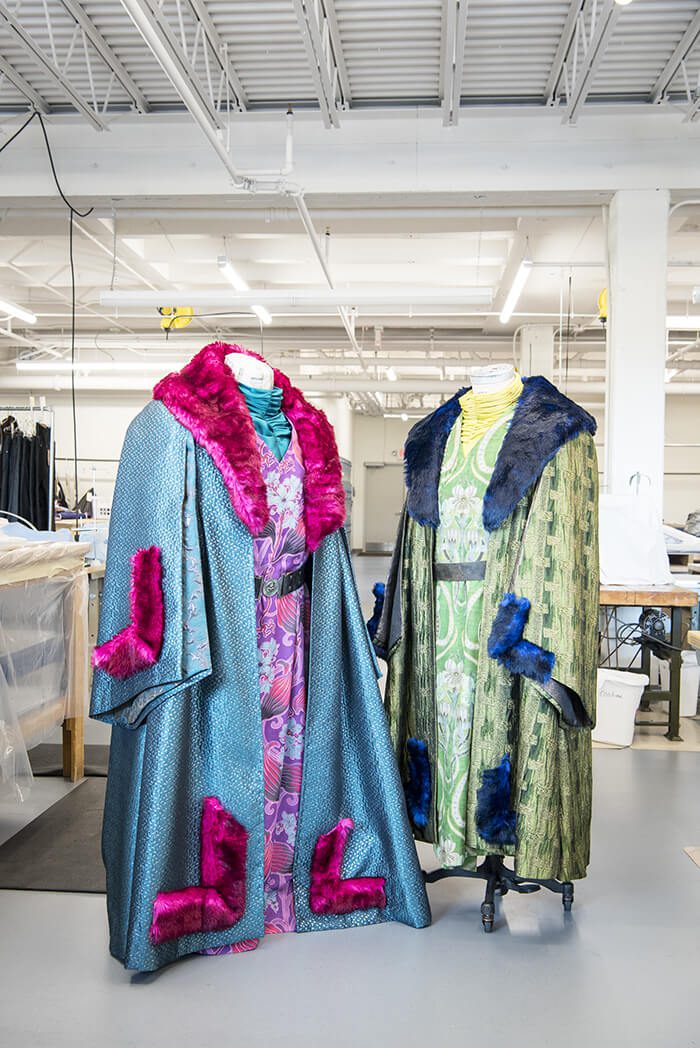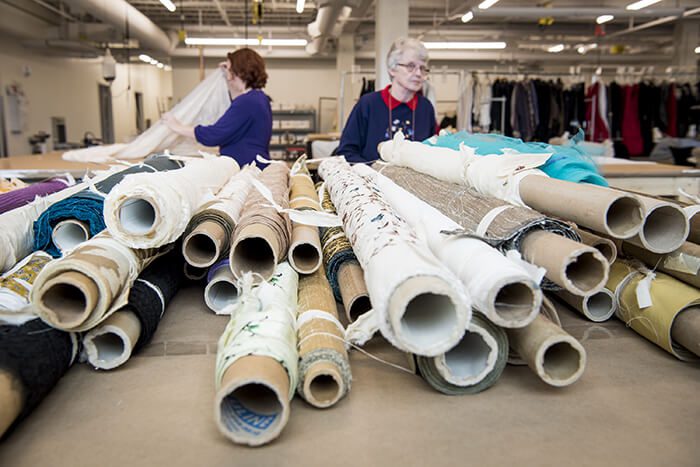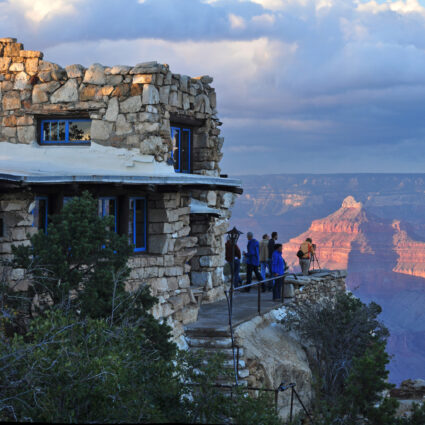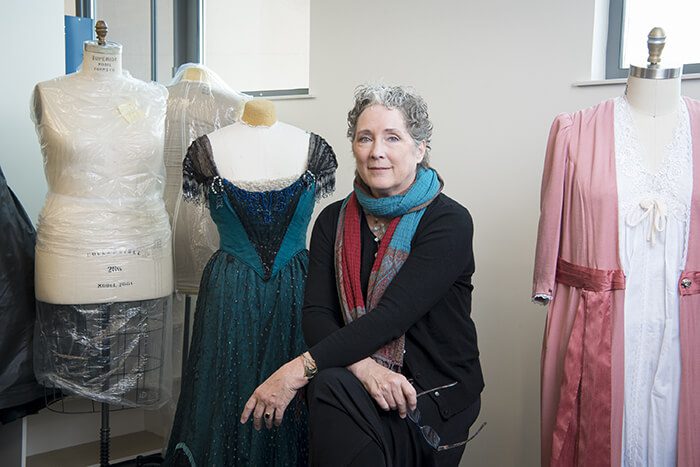
‘It’s one thing to draw a picture of a lady in a blue dress,” says Missy West, Costume Director of the Santa Fe Opera. “But what’s the blue dress made of? What period of history are we working in? Is the shape of the singer going to work with the shape of what you’ve drawn?” It’s early May, and West is sitting at a worktable in the relatively quiet costume shop, which is submerged behind the stage of the open air performance venue. This is where she started her career in opera, in 1990. Back then, she didn’t know to ask any of these questions—let alone how to answer them.
“My role was second hand to the draper, so I was an assistant to the assistants,” says West. “I was so green.” She remembers toiling in the dark, wooden confines of the old costume shop, which lacked air conditioning and had one row of tiny windows. After one summer here, West continued on to the Spoleto Festival in Charleston, worked for fashion designers and costume shops in New York City, and spent twenty-three years as costume director of the San Diego Opera. She returned to the Santa Fe Opera exactly a year ago today. The costume shop was unrecognizable.
In 2015, the opera completed a $30.6 million renovation project that significantly expanded and improved its production facilities. Now the costume shop occupies a series of lofty, well-lit rooms with expansive workspaces, large windows, and, yes, air conditioning. West has risen from humble apprentice to the shop’s fearless leader, overseeing the intricate work of the head dyer, the head of crafts, the head of millinery, four drapers, and an army of assistants. Their job is to work with five designers—one for each of this season’s productions—to transform pure fantasy into theatrical reality.
“It’s my schedule and my budget, and it’s their vision,” says West. “Our job is to get that vision onstage, because the directors and designers are working together to create this world.” Each season at the Santa Fe Opera, five cycles of this process overlap in the span of just a few months.
In a week’s time, West’s crew will scale up, and the big push will begin. For now, the head of each department bustles around, taking detailed notes for their soon-to-arrive assistants. The season’s first show debuts June 30, and racks are already filling up throughout the shop with garment mock-ups for each production. Contemporary business duds that will appear in The (R)evolution of Steve Jobs hang beside late 1800’s formalwear for the masked ball in Die Fledermaus. Fanciful wedding garb for Lucia Di Lammermoor, a Scottish take on Romeo and Juliet, flanks the vivid robes of the seductive sorceress who is the title character of Alcina.
Our job is to get that vision onstage, because the directors and designers are working together to create this world.
This season’s most intricate production is The Golden Cockerel, a 1909 opera by Nikolai Rimsky-Korsakov that’s based on a poem by Alexander Pushkin. Composed in the twilight of the Russian Empire, it follows the tyrannical King Dodon as he heads off to battle and falls in love with his beautiful foe, Queen Shemakha. At the center of the century-old story is a topical moral: if you wield great power foolishly, your kingdom will come crashing down.
The production’s scenic and costume designer, Gary McCann, takes cues from the dress of turn of the century aristocrats. Here’s how three members of the costume department are working the monumental vision that he shares with director Paul Curran.

Dyeing
“The lights are really hot in here, because they’re color accurate,” says Cheri Vasek, flipping some switches near the door of the dye shop to bring up glaring stage lights high above. Vasek has worked every summer at the Santa Fe Opera since 1993, spending her first decade in the props department and then hopping over to the dye shop. “I had done dye work before, but there’s a level of precision that’s expected here,” she says. “It’s a lot of formulas. You have to take really good notes, because everything has to be replicable.”
This week, Vasek is tackling a tricky alchemy project: turning nylon cord into chain mail. An army of local volunteers knitted countless panels of white nylon this winter, and now they’re piled in laundry baskets atop Vasek’s worktable. Her task is to dye the nylon black, the fussiest color in her bottled palette because it’s made by mixing all other colors.
“Most blacks either have a red base to them or a blue base,” Vasek says, laying out a few test sheets. “I used the acetate nylon black on this one. Looks navy blue, right?” The Golden Cockerel calls for thirty sets of chain mail. If Vasek diverged from her black formula partway through the process, different soldiers might fluoresce blue or red onstage. Hence her impeccable notes, which already litter the shop.
Vasek holds up a nylon panel that emerged from the vat in an intense shade of black. It’s the winning formula, but she’s still not sure all of the nylon will absorb it in the same way. “All of these knitters got different spools of cord, so who knows if the material is consistent or not,” she says. She’ll have to boil each load of nylon for 45 minutes to take the color, a long and suspenseful process. In all, the mountain of textiles before her will take six to seven days to dye. “That’s if we’re lucky,” she says.
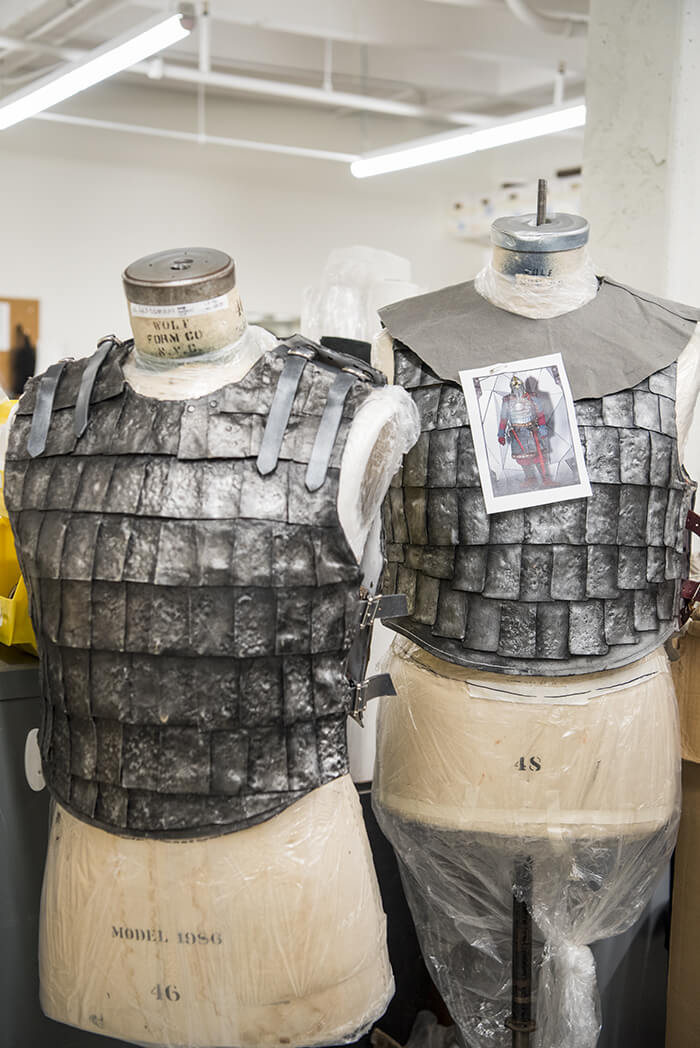
Crafting
“No one usually even knows we exist; everyone thinks we just buy stuff from the shop,” Helen Fuller says. She has headed Santa Fe Opera’s craft department for the past three years and has worked on movies and operas for over forty years. This is a career where it pays to be invisible. Starting next week, Fuller and her crew will work ten hours a day, six days a week to produce one trompe l’oeil creation after the next.
Next week, when Cheri Vasek’s nylon panels are dyed black, she’ll deliver them to the craft department. Fuller and her team will place the nylon in a hot press with sheets of mylar, binding a shimmering layer of silver to the black fibers and completing the illusion. Presently, Fuller is hard at work on another part of the costume: armored breastplates.
“If you have a big budget, you can actually make it out of metal, mold it and cast it in plastic,” Fuller says. Instead, she’s sculpting scales from inexpensive thermal plastic and riveting them onto a base. With the blast of a heat gun, the material will freeze in any shape. “You can see there’s lots of texture in there,” she says, pointing to a prototype on a nearby mannequin. “We’re going out and molding the sheets onto rocks and things, and then we’ll do silver highlights and lowlights so that it really glistens.”
It might have taken thirty minutes for a person to get dressed during that historical period, but this person needs to change costumes in three minutes.
On the sides of the prototype, faux leather buckles appear to hold the costume together. Hidden beneath the buckles are metal snaps that make it easier to remove the breastplate in one fell swoop. Innovations like this are known as rigging, and they’re vital for the quick costume changes that happen backstage. “There will be eighteen men dropping all of their armor in this tiny area backstage, in about a minute,” says Fuller. “They pop everything off and drop it onto mattresses, otherwise everything would go clunk.”
One of Fuller’s assistants hustles into the craft shop holding a sheet of paper. She’s printed out an image of a metal door pull. “Oh, perfect. Perfect!” Fuller says. They’ve been searching for an element that will appear on a costume for the female chorus members. In the designer’s sketch, it’s a small hoop that hangs from a neckpiece and anchors decorative chains that cascade down their dresses. “I looked at hardware stores, pet stores, saddlery stores, marine yachting websites,” says the assistant. “Then someone was like, ‘Look at this fancy little door handle.’ That’s it!” Fuller beams. “It’s an incredibly creative job. You have to draw inspiration from everywhere,” she says.
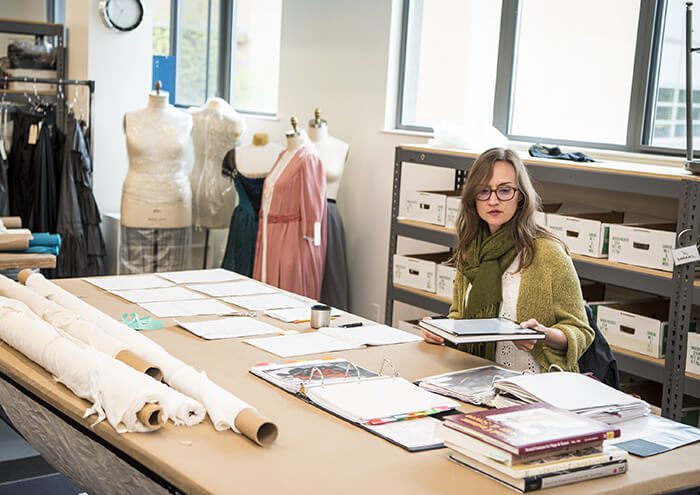
Draping
“I have to take a two-dimensional drawing, design a two-dimensional pattern, and turn it into a three-dimensional garment,” says Sarah Lankenau. She’s one of four drapers who will guide teams of eight people as they build every costume that will appear onstage this season. It starts with fastidious prep work, as Lankenau does research on each featured time period, creates patterns, and outlines to-do lists for her team. Her work is complicated by the fact that nothing is set in stone until the designers and performers arrive. Only then can she get final approval on designs and make sure the measurements she’s received from the performers are still correct.
“In the meantime, I’ll make mock-ups of the garments using stock fabric,” Lankenau says. She flips through a book of drawings for The Golden Cockerel and stops on the page for the dress featuring the craft department’s golden door pull. “Here’s this beautiful, diaphanous gown that we’ll make from silk charmeuse and silk chiffon,” she says. “For the mock-up, I’m using a polyester fabric that has a drape to it that’s similar to silk charmeuse. This is when we work out any changes in style lines before we cut into the expensive fabrics.”
For the moment, all Lankenau has to go by is the designer’s drawings and notes and her own formidable knowledge of draping. Her first season at Santa Fe Opera was in 2007, when she worked as a stitcher. In the years between, she completed contract work for the Opera before coming on three years ago as a full-time draper. She starts her process by doing extensive historical research on garments from the period or periods from which each production draws its aesthetic. As she starts building the costumes, the particularities of constructing garments for the opera stage come into play.
“There’s a lot of engineering,” Lankenau says. “It might have taken thirty minutes for a person to get dressed during that historical period, but this person needs to change costumes in three minutes.” Sewing magnetic clasps and elastic bands into seams buys precious time for the actors to make a quick change, sip water, and get back into character.
Then there’s the fact that performers are engaging in a spectacular physical feat. Collars can’t be too constricting. Hats shouldn’t cover a singer’s ears or block their view of the conductor. Pants and bodices must allow for two to three inches of expansion as the performers take deep breaths—but they also need to stay in place when the breath is released. Straps must adhere to a performer’s rising and falling shoulders.
“The performer shouldn’t have to think about their costume when they’re onstage,” says Lankenau. “I feel like I’m successful when I can give the designer what they envisioned, do it in the parameters of the budget, and help the performer become fully immersed in the world of the opera.”
